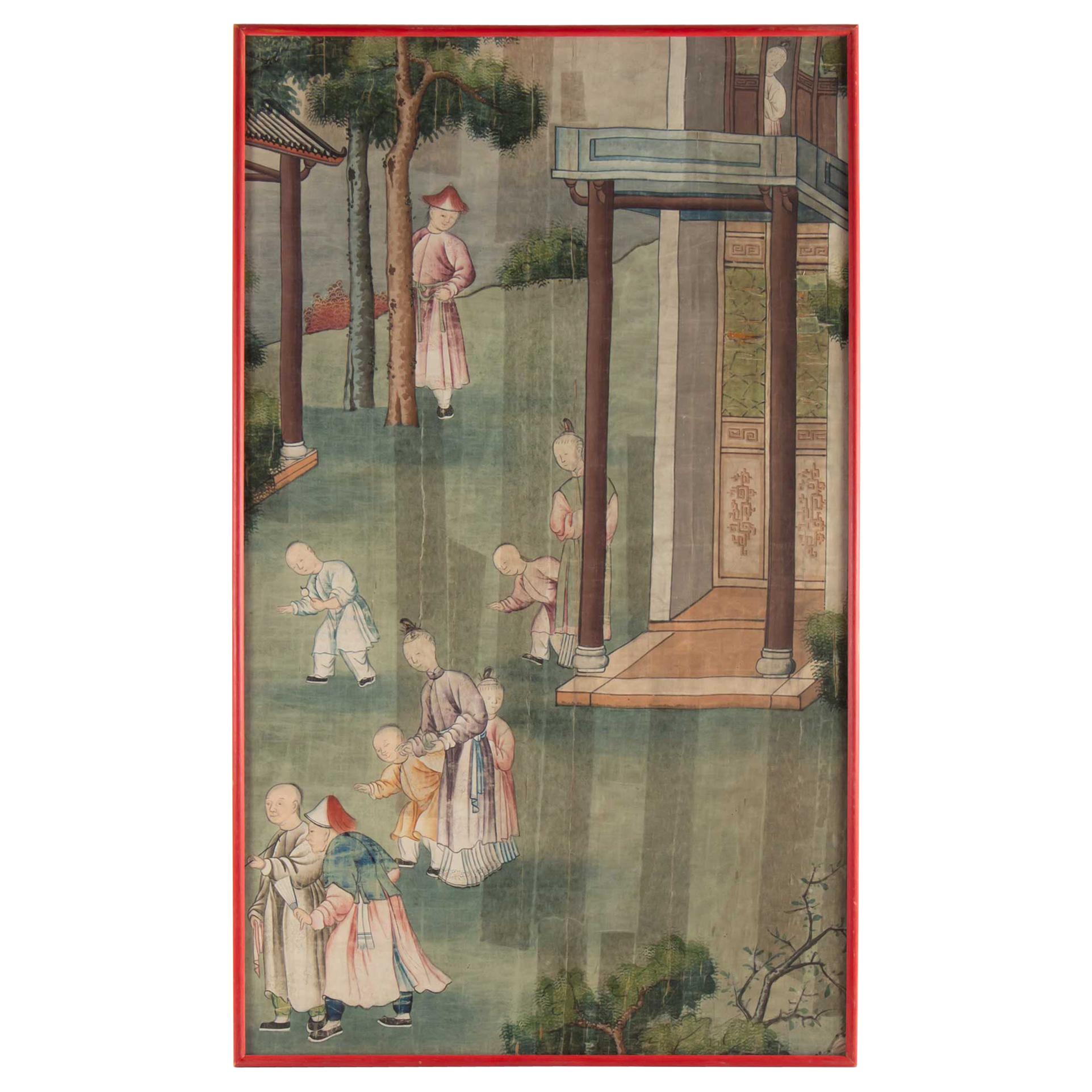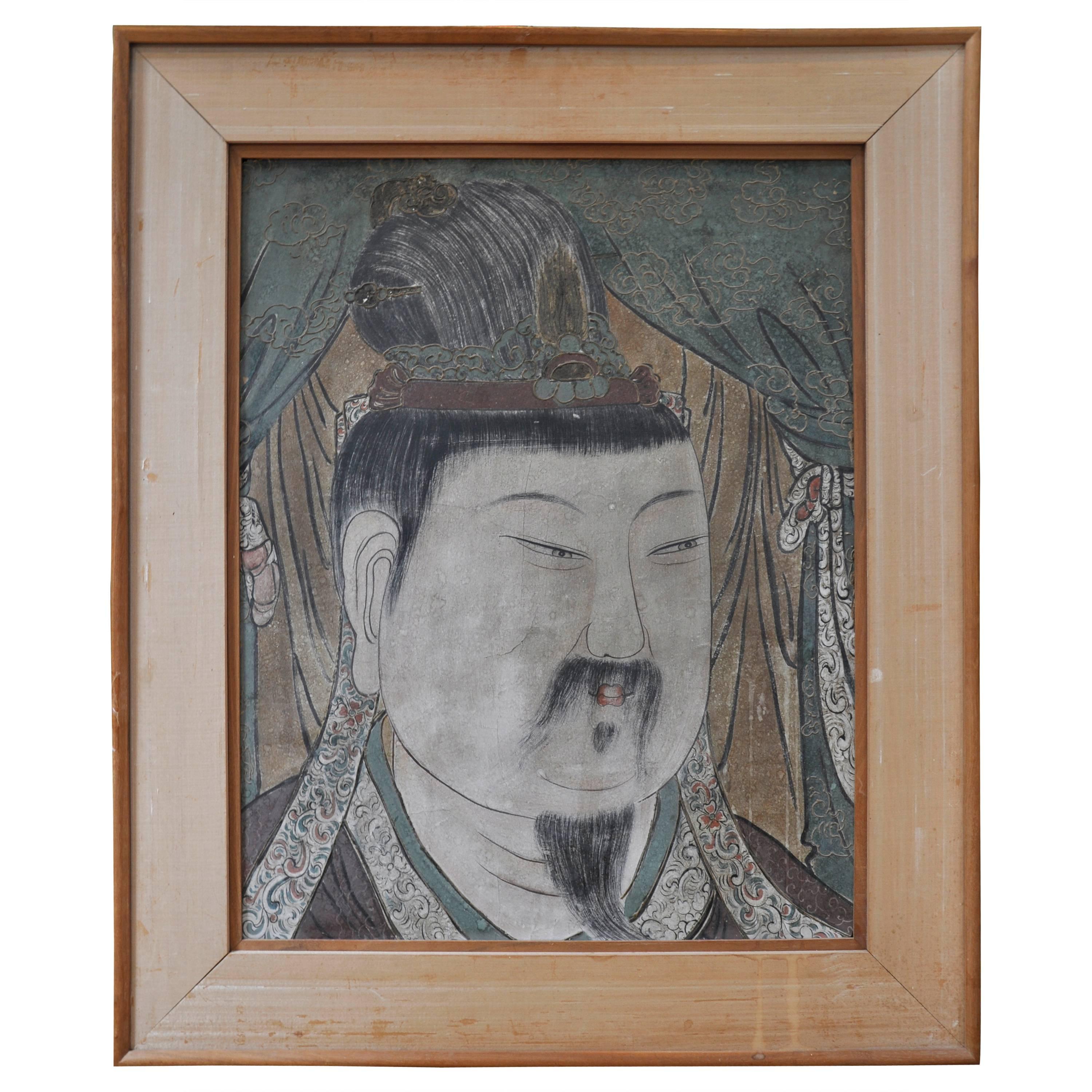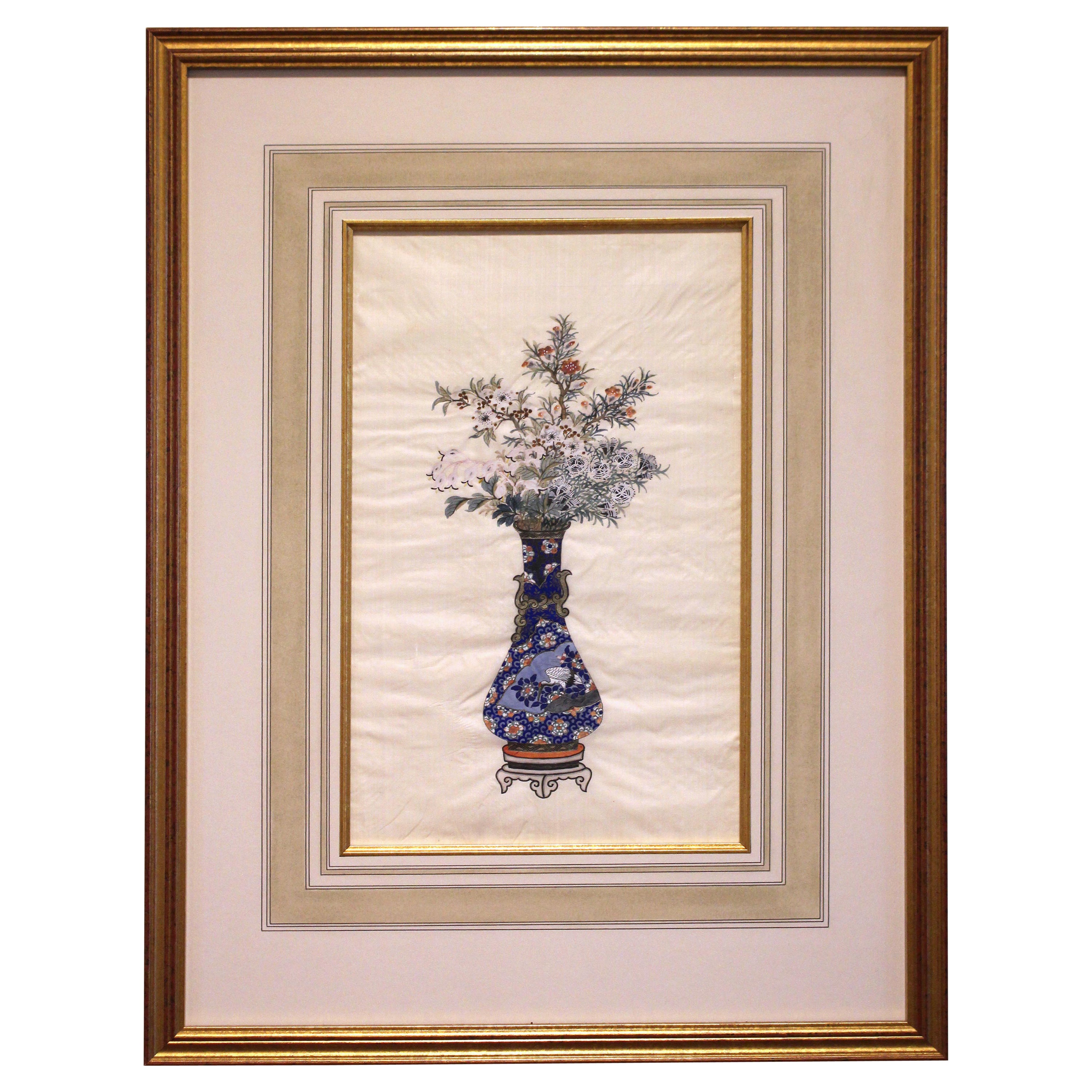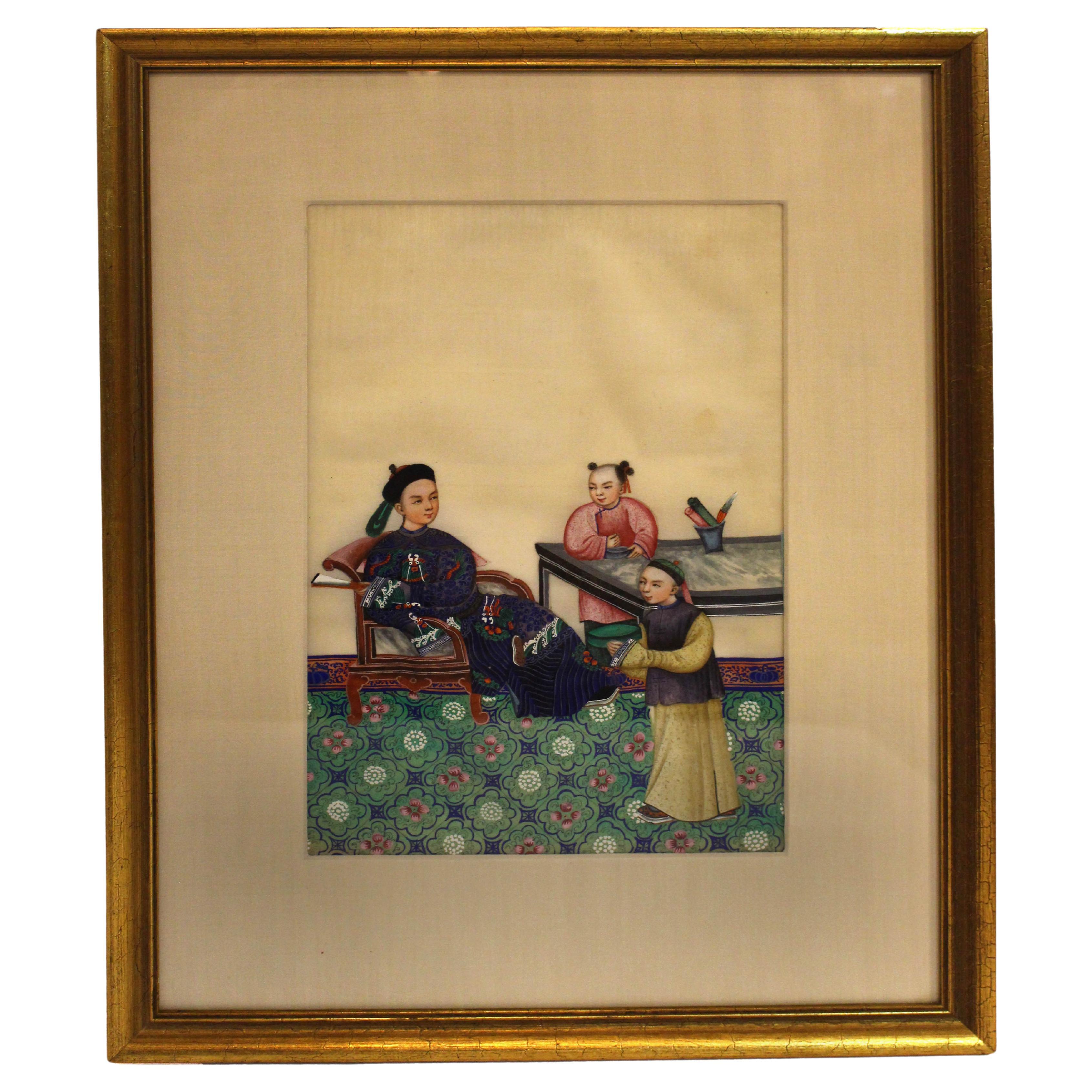Items Similar to Immortal He Xiangu Painting on Canvas, China, 19th Century Asian Art
Want more images or videos?
Request additional images or videos from the seller
1 of 8
Immortal He Xiangu Painting on Canvas, China, 19th Century Asian Art
About the Item
Chinese painting depicting He Xiangu reproduced three times but with a different attribute: up a lotus flower, bottom left a fly hunt and bottom right again the lotus flower, each time surrounded by disciple the one praying right, the one on the left seems to bring him a bowl.
Pigments on linen or hemp,
19th century.
He Xiangu or Ho Hsien-ku, "Immortal Demoiselle He," is an immortal Taoist, a member of the group of Eight Immortals. She is represented holding in her hand a lotus symbolizing spiritual fulfillment, and sometimes also a sheng, a peach of immortality, a wooden ladle or a flyer, accessory of religious. She is sometimes given as a disciple of Lü Dongbin, and Ming theatrical or literary works have imagined a romantic plot between the two. Tradition has made it a woman of the Tang Dynasty who has devoted herself to celibacy to devote herself to Dao. She would have lived under the reigns of Wu Zetian and Zhongzong. . Wu Zetian would have asked to meet her, which she would have accepted or not according to the versions. A "Song" book makes it a contemporary of General Di Qing (1008-1057) to whom she predicts a victory.
- Dimensions:Height: 27.56 in (70 cm)Width: 20.87 in (53 cm)Depth: 0.4 in (1 cm)
- Style:Qing (Of the Period)
- Materials and Techniques:
- Place of Origin:
- Period:
- Date of Manufacture:1800
- Condition:Wear consistent with age and use. some lacks.
- Seller Location:Beuzevillette, FR
- Reference Number:1stDibs: LU266337427953
About the Seller
4.9
Platinum Seller
These expertly vetted sellers are 1stDibs' most experienced sellers and are rated highest by our customers.
Established in 2010
1stDibs seller since 2017
243 sales on 1stDibs
Typical response time: 2 hours
- ShippingRetrieving quote...Ships From: Beuzevillette, France
- Return PolicyThis item cannot be returned.
More From This SellerView All
- Asian Mandala Tanka circa 1900Located in Beuzevillette, FRVery beautiful tanka mandala of the 19th century painted on canvas . Buddha is in the center with the naga on his right arm, surrounded by others arranged like the rays of the sun. T...Category
Antique 19th Century Asian Paintings and Screens
MaterialsCanvas
- Set of 6 Large Kakemonos Japanese Mythology, 19th Century Japan circa 1800 EdoLocated in Beuzevillette, FRBeautiful set of 6 large kakemonos from 19th century Japanese mythology. Paper support with a canvas pasted on the paper Wonderful set that is part of Japan's history and beliefs When not hung, the Kakemonos are rolled up. circa 1800 - Japan - Edo Period A kakemono translates as "object to hang". In Japan this refers to a painting or calligraphy, most often done on silk or paper framed in a scroll that was intended to be hung on walls or in public lighting. This particular form, which allows them to be in a roll, dates back to the Tang dynasty in China (this would be related to the copying and preservation of ancient Buddhist texts). A Kami is a deity or spirit worshipped in the Shinto religion. A Yokai is a spirit, ghost, demon, or strange apparition from the creatures of Japanese folklore. Each of these kakemonos represents a unique story: - A kami, a Japanese deity, is shown painting a rainbow. Indeed, he performs the action with his right hand while his left hand holds a kind of basket with three pots of paint. This kami has a rather closed attitude. He is standing in a dark and tormented sky. Below this figure, 8 villagers are dressed in traditional Japanese clothes. Their faces are softened. They are not afraid of the elements made by the kami above their heads. - A character with an unreal look is holding a kind of jar with his two hands, which he spills on human figures above. This being is floating in the air, probably a character from mythology, perhaps Susanoo. Underneath, villagers on umbrellas. They are trying to protect themselves as best they can from what is falling on them. One of them is carrying baskets with fish on her shoulders. A character in the background is thrown forward and falls. - On this kakemono, the god Raijin, dressed in a white and blue outfit, strikes the sky with his two drum hammers to create lightning and its thunderous sound. Surrounded by Tomoe and a long red scarf, Raijin, enraged and with dishevelled hair, creates a dark and violent storm. The villagers seem frightened by this meteorological phenomenon. One of the villagers can be seen fainting in the arms of a man. This scene may seem chaotic, but Japanese legend tells us that once a field is struck by lightning, the harvest is good. - On this kakemono, we see an unreal-looking figure holding a fan, as if he were sweeping away the bad weather, or simply producing gusts of wind. He is probably the kami of wind and air, Shina tsu-hiko. The figures below him seem surprised by so much wind. An umbrella flies away on the left, the women hold their hair and scarf, the clothes are caught in the power of the wind, there is even a woman on the ground on the bottom left. - This Kakemono represents a short moment. This Raiju is a yokai (ghost spirit...Category
Antique 19th Century Japanese Edo Paintings
MaterialsPaper
- Chinese Coconut tea pot - China - late 18th / early 19th - Qing - Asian ArtLocated in Beuzevillette, FRVery pretty and old tea pot, gourd shaped, in sculpted coconut, chiseled and mounted on pewter. The cap is also made of pewter. The coconut is decorated with imperial motifs. Chinese...Category
Antique 19th Century Chinese Qing Tea Caddies
MaterialsTin
- A.Bouverat Chinese Inspired Lacquered Panel Hand-Painted 20th CenturyBy A. BouveratLocated in Beuzevillette, FRVery beautiful rare and large lacquer of Chinese inspiration. Representation of a green space with many plants such as cherry trees and magnolia. A bird crosses the lacquer with its ...Category
20th Century French Chinoiserie Paintings
MaterialsLacquer
- Young Boy Playing the Flute Sculpture on Marble Terrace, 19th CenturyLocated in Beuzevillette, FRCharming sculpture in spelter with bronze patina, in the style of Auguste Moreau, representing a young flute player dressed in country clothes, carrying his flute in his left hand an...Category
Antique 1870s French Louis XV Figurative Sculptures
MaterialsMarble, Spelter
- 19th Century Lectern Louis-Philippe PeriodLocated in Beuzevillette, FRThis Louis-Philippe period table lectern in cherrywood resting on four turned legs, has three positions for three different reading angles. France, circa 1840.Category
Antique 1840s French Louis Philippe Books
MaterialsCherry
You May Also Like
- Silk, Chinese Painting, 19th Century, Temple Scene, AsiaLocated in Saint-Ouen, FRSilk, Chinese painting, 19th century, temple scene, Asia Measures: H 81cm, W 48cm, W 1cm.Category
Antique 19th Century Chinese Chinoiserie Paintings and Screens
MaterialsSilk
- Antique Chinese School Painting On Silk 19th CenturyLocated in Forney, TXA stunning antique Chinese school ink wash painting, 19th century, ink and color on silk, finely detailed, richly decorated, elegantly colored, depicting landscape courtier processio...Category
Antique 19th Century Asian Qing Paintings and Screens
MaterialsSilk
- 19th Century Chinese PaintingLocated in Dallas, TXImperial portrait on paper.Category
Antique 18th Century Chinese Other Paintings and Screens
MaterialsPaint
- Late 19th Century Chinese Painting on SilkLocated in Chapel Hill, NCLate 19th century Chinese painting on silk. For the export market. A vase with a crane in the reserve is filled with flowering b...Category
Antique Late 19th Century Chinese Chinese Export Paintings and Screens
MaterialsSilk
- Mid-19th Century Chinese Painting on Rice or Pith PaperLocated in Chapel Hill, NCMid-19th century Chinese Painting on Rice or Pith Paper. Gouache or opaque watercolor of a student & attendants. Note remarkable details including marble panelled chair...Category
Antique Mid-19th Century Chinese Qing Paintings and Screens
MaterialsPaper
- Chinese Qing Dynasty 19th Century Official's Wife Painting on Linen CanvasLocated in Yonkers, NYA Chinese Qing Dynasty period framed painting from the 19th century of an official's wife with bird-adorned buzi, painted on a linen canvas. Created in the North-Eastern province of Shanxi during the Qing dynasty, this 19th century painting showcases a frontal depiction of an official's wife recognizable thanks to the bird-themed rank badge sitting on an elegant armchair with scrolling arms and carved apron. Wearing a red robe and topped with an ornate headdress, the figure is highlighted with gold foil accents and stands out beautifully on a linen canvas. The print size is 17.5"W x 41.5"H. These paintings traditionally come from Shanxi province which was home to many of the wealthy merchant families associated with the imperial court during the Qing dynasty. Set inside a custom made frame, this 19th century Qing Dynasty official's wife painting...Category
Antique 19th Century Chinese Paintings
MaterialsCanvas, Plexiglass, Wood
Recently Viewed
View AllMore Ways To Browse
Chinese General
Antique Flower Book
Wooden Book
The Immortals
Chinese Antique Book
19th Century Chinese Painting Screen
Religious Art Wooden
1800 Chinese Art
Chinese Screen Two
Asian Antique Accessories
Antique Hemp
Hand Holding A Book
Antique Religious Book
Woman Holding Flower
Woman Holding Flowers
Chinese Qing Dynasty Paintings
Antique Wooden Screen
Chinese Qing Screen





